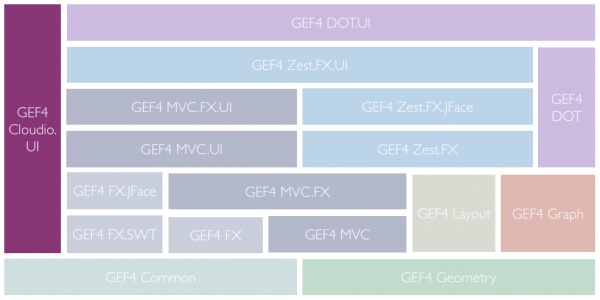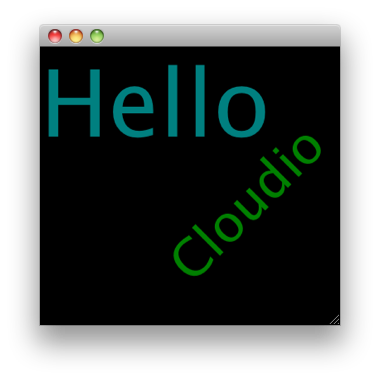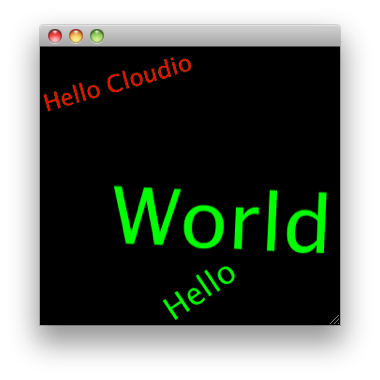Notice: This Wiki is now read only and edits are no longer possible. Please see: https://gitlab.eclipse.org/eclipsefdn/helpdesk/-/wikis/Wiki-shutdown-plan for the plan.
GEF/GEF4/Cloudio
Note to non-wiki readers: This documentation is generated from the Eclipse wiki - if you have corrections or additions it would be awesome if you added them in the original wiki page.
Introduction
The GEF4 Cloudio component provides support for visualizing tag clouds within a dedicated SWT Canvas or JFace viewer. It is internally decomposed into the single Cloudio.UI module. There are also a couple of undeployed Cloudio UI Examples that demonstrate usage of the (still internal) API. The user documentation is provided in terms of the GEF4 Cloudio User Guide.
Cloudio.UI
- feature: org.eclipse.gef4.cloudio.ui
- bundle: org.eclipse.gef4.cloudio.ui
The Cloudio.UI module of GEF4 Cloudio realizes the Tag cloud view end-user features, as outlined in the GEF4 Cloudio User Guide. It does not provide any public API yet, but exposes its internal API (guarded by an x-friends directive).
Cloudio.UI
- feature: org.eclipse.gef4.cloudio.ui
- bundle: org.eclipse.gef4.cloudio.ui
The Cloudio.UI module of GEF4 Cloudio provides SWT- and JFace-based support for rendering tag clouds.
{Root}
- package: org.eclipse.gef4.cloudio.internal.ui
The {Root} package provides an SWT widget (TagCloud) and a JFace viewer (TagCloudViewer), which support rendering of word clouds.
TagCloud, Word
A TagCloud is a special org.eclipse.swt.widgets.Canvas, dedicated to display a tag cloud. It expects the to be rendered words and related properties (weight, angle, color, font) to be represented as Word input elements and can be created as follows:
public static void main(String [] args) { final Display display = new Display(); final Shell shell = new Shell(display); TagCloud cloud = new TagCloud(shell, SWT.NONE); // Generate some dummy words - color, weight and fontdata must // always be defined. List<Word> words = new ArrayList<Word>(); Word w = new Word("Hello"); w.setColor(display.getSystemColor(SWT.COLOR_DARK_CYAN)); w.weight = 1; w.setFontData(cloud.getFont().getFontData().clone()); words.add(w); w = new Word("Cloudio"); w.setColor(display.getSystemColor(SWT.COLOR_DARK_GREEN)); w.setFontData(cloud.getFont().getFontData().clone()); w.weight = 0.5; w.angle = -45; words.add(w); shell.setBounds(50,50, 300, 300); cloud.setBounds(0,0, shell.getBounds().width, shell.getBounds().height); // Assign the list of words to the cloud: cloud.setWords(words, null); shell.open(); while (!shell.isDisposed()) { if (!display.readAndDispatch()) display.sleep(); } display.dispose(); }
The result should look similar to this (String positions are assigned by random):
TagCloudViewer, ICloudLabelProvider
A TagCloudViewer is a special org.eclipse.jface.viewers.ContentViewer, that renders a tag cloud. It is internally based on a TagCloud and enhances the functionality of the tag cloud: it is possible to select
and deselect elements by mouse click, to zoom in or out using the mouse wheel and to display tool tips on words. The TagCloudViewer expects an org.eclipse.jface.viewers.IStructuredContentProvider and an ICloudLabelProvider. The words that are to be rendered in the TagCloud are inferred by queuing the ICloudLabelProvider for labels of the elements returned by the org.eclipse.jface.viewers.IStructuredContentProvider. The properties of the words (weight, color, font, angle) are retrieved via the ICloudLabelProvider for each word as well.
A TagCloudViewer can be used as follows:
import java.util.ArrayList; import java.util.Arrays; import java.util.List; import org.eclipse.jface.viewers.BaseLabelProvider; import org.eclipse.jface.viewers.ISelectionChangedListener; import org.eclipse.jface.viewers.IStructuredContentProvider; import org.eclipse.jface.viewers.IStructuredSelection; import org.eclipse.jface.viewers.SelectionChangedEvent; import org.eclipse.jface.viewers.StructuredSelection; import org.eclipse.jface.viewers.Viewer; import org.eclipse.swt.SWT; import org.eclipse.swt.graphics.Color; import org.eclipse.swt.graphics.Font; import org.eclipse.swt.graphics.FontData; import org.eclipse.swt.widgets.Display; import org.eclipse.swt.widgets.Shell; import org.eclipse.zest.cloudio.ICloudLabelProvider; import org.eclipse.zest.cloudio.TagCloud; import org.eclipse.zest.cloudio.TagCloudViewer; public class TagCloudViewerSnippet { static class CustomLabelProvider extends BaseLabelProvider implements ICloudLabelProvider { private Font font; public CustomLabelProvider(Font font) { this.font = font; } @Override public String getLabel(Object element) { return element.toString(); } @Override public double getWeight(Object element) { return Math.random(); } @Override public Color getColor(Object element) { return Display.getDefault().getSystemColor(SWT.COLOR_GREEN); } @Override public FontData[] getFontData(Object element) { return font.getFontData(); } @Override public float getAngle(Object element) { return (float) (-90 + Math.random() * 180); } @Override public String getToolTip(Object element) { return element.toString(); } } public static void main(String [] args) { final Display display = new Display(); final Shell shell = new Shell(display); TagCloud cloud = new TagCloud(shell, SWT.NONE); final TagCloudViewer viewer = new TagCloudViewer(cloud); // A simple content provider for a list of elements viewer.setContentProvider(new IStructuredContentProvider() { @Override public void dispose() { } @Override public void inputChanged(Viewer viewer, Object oldInput, Object newInput) {} @Override public Object[] getElements(Object inputElement) { return ((List<?>)inputElement).toArray(); } }); // A simple label provider (see above) viewer.setLabelProvider(new CustomLabelProvider(cloud.getFont())); // Demo of an selection listener viewer.addSelectionChangedListener(new ISelectionChangedListener() { @Override public void selectionChanged(SelectionChangedEvent event) { IStructuredSelection selection = (IStructuredSelection) viewer.getSelection(); System.out.println("Selection: " + selection); } }); // Demo data List<String> data = new ArrayList<String>(); data.add("Hello"); data.add("World"); data.add("Hello Cloudio"); shell.setBounds(50,50, 300, 300); cloud.setBounds(0,0, shell.getBounds().width, shell.getBounds().height); // Set the input of the viewer viewer.setInput(data); // Set initial selection: viewer.setSelection(new StructuredSelection(Arrays.asList("Hello Cloudio"))); shell.open(); while (!shell.isDisposed()) { if (!display.readAndDispatch()) display.sleep(); } display.dispose(); } }
The result will look similar to this:
Layout
- package: org.eclipse.gef4.cloudio.internal.ui.layout
The Layout package provides the contract (ILayouter) for algorithms that perform placement of words during tag cloud generation, as well as a related default implementation (DefaultLayouter).
ILayouter, DefaultLayouter
An ILayouter is used by a TagCloud to compute the actual placement of words inside a given area. The DefaultLayouter places words similar to the algorithm used by Wordle.
Util
- package: org.eclipse.gef4.cloudio.internal.ui.util
The Util package provides a two-dimensional tree structure to store non-overlapping rectangles (RectTree), a custom rectangle implementation (SmallRect) with short precision used by it (which will probably be replaced with org.eclipse.gef4.geometry.planar.Rectangle in the future), and a CloudMatrix, which represents a drawable area within a tag cloud through a RectTree.
RectTree, RectNode, SmallRect
A RectTree is a two-dimensional tree structure to store non-overlapping rectangles that are represented through RectNodes, which are internally based on a short-precision rectangle representation (SmallRect).
CloudMatrix
A CloudMatrix represents the drawable area within a tag cloud (and information about which word is placed at which coordinate), internally based on a RectTree.



